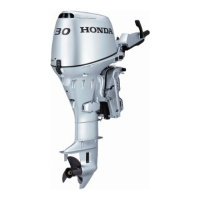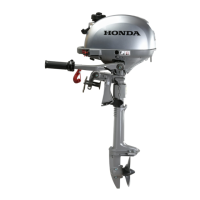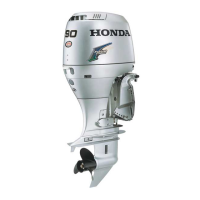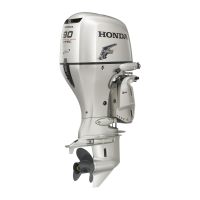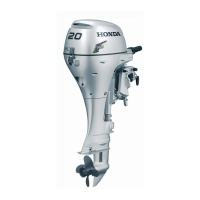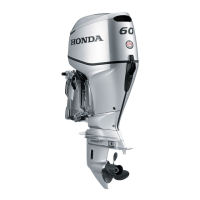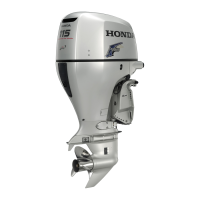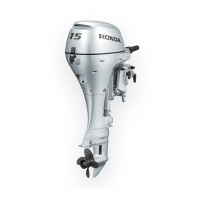Do you have a question about the Honda Marine BF25A and is the answer not in the manual?
Discusses the importance of safety and how hazards are communicated.
Highlights the operator's duties in ensuring safe use and preventing accidents.
Guidance on safe refueling practices for gasoline, emphasizing flammability risks.
Warns about the dangers of carbon monoxide from exhaust gas in enclosed areas.
Explains codes used to identify different control and feature configurations.
Diagrams and labels showing the location of components and controls for the tiller handle type.
Diagrams and labels showing the location of components and controls for the remote control type.
Describes the features and components of the optional portable fuel tank.
Explains the function and operation of the engine stop switch and its clip.
Details the choke knob's function in enriching the fuel mixture for starting.
Describes the throttle grip for speed control and the friction knob for setting resistance.
Explains how to use the gearshift lever to select forward, neutral, or reverse gears.
Covers operation of recoil and electric starter buttons for engine ignition.
Describes the ignition switch for starting and stopping the engine on remote control models.
Details the emergency stop switch and lanyard system for immediate engine shutdown.
Explains the choke/fast idle lever for starting and preventing stalling.
Describes the lever for selecting gears and controlling engine speed on side-mount types.
Details the manual choke knob for starting when the battery is discharged.
Explains the function of the engine cover latch for securing the engine cover.
Describes the rod used to limit the tilt angle of the outboard motor.
Explains how the trim tab compensates for torque steer and adjusts steering effort.
Details how the steering friction bolt adjusts steering resistance for easier turning or stability.
Explains how the tilt lever raises the outboard motor for shallow water or mooring.
Describes the fuel gauge built into the portable fuel tank cap.
Explains the oil pressure indicator light and its meaning for engine lubrication.
Details the overheating indicator light and buzzer for engine temperature warnings.
Explains the cooling system indicator for monitoring water flow and engine cooling.
Describes the overrev limiter that prevents mechanical damage from excessive engine speed.
Explains the anode's role in protecting the motor from corrosion.
Provides capacity and fuel gauge information for the portable fuel tank.
Details the fuel cap vent knob for sealing the portable fuel tank.
Explains the function of the fuel priming bulb for delivering fuel to the engine.
Guidance on selecting the correct outboard motor horsepower for the boat.
Specifies the transom thickness range for installing Honda outboard motors.
Details the correct mounting position and height relative to the boat's hull.
Describes how to attach the outboard motor to the boat transom and secure it.
Explains how to adjust the transom angle for optimal propeller alignment.
Provides instructions for connecting the battery for 12-volt systems.
Details how to connect the DC receptacle for charging and accessories on non-electric start models.
Instructs on correctly connecting battery cables to the positive and negative terminals.
Guides on checking readiness, knowledge, and familiarity before operating the motor.
Emphasizes wearing PFDs and securing the emergency stop switch lanyard.
Lists visual checks for leaks, secure mounting, and proper control operation.
Covers checks for oil level, propeller, anode, and tool kit condition.
Advises on understanding operation, controls, and avoiding enclosed areas for exhaust.
Details the 10-hour break-in period for proper engine wear-in and performance.
Instructions on adjusting the transom angle rod to limit tilt angle during operation.
Covers placement, securing, and venting of the portable fuel tank.
Details how to connect the fuel hose securely between the tank and outboard.
Explains how to use the priming bulb to supply fuel to the engine before starting.
Step-by-step guide for starting the engine using the tiller handle controls.
Details checking gearshift, setting choke, and aligning throttle for engine start.
Covers operating recoil and electric starters, including troubleshooting start failures.
Step-by-step guide for starting the engine using remote control.
Details choke/fast idle lever and ignition switch for starting the engine.
Instructions for starting the engine manually using the emergency starter rope.
Covers removing covers, setting controls, and using the emergency starter rope.
Explains both emergency and normal engine stopping procedures.
Details the steps for normal engine shutdown using throttle and ignition switch.
Describes gear selection and throttle control for H Type models.
Explains how to use the throttle friction knob for holding a steady speed.
Describes gear selection and throttle control for R Type remote models.
Details adjusting the throttle friction for holding a constant speed with remote control.
Explains how to steer using the tiller handle and steering friction.
Describes steering the boat using remote control, similar to an automobile.
Provides tips for fuel economy, handling rough water, and overrev limiter.
Explains trim angles for stable cruising, compensating for load and conditions.
Guides on tilting the motor for shallow water, beaching, or launching.
Instructions for tilting the outboard motor for mooring, beaching, and launching.
Highlights how good maintenance ensures safe, economical, and trouble-free operation.
Lists essential safety precautions to follow during maintenance and repairs.
Lists the tools supplied with the motor for maintenance and emergency repairs.
Provides a schedule for regular service intervals based on time or operating hours.
Details how to adjust the trim tab to compensate for torque steer and equalize steering effort.
Instructions for removing and reinstalling the engine cover for access.
Step-by-step guide to checking the engine oil level using the dipstick.
Instructions for draining, refilling, and checking engine oil capacity.
Specifies recommended SAE oil viscosity and API service classification.
Details how to check the gear oil level in the outboard motor.
Instructions for draining and refilling the gear oil, including checking for water contamination.
Identifies key points for applying marine grease and anticorrosion oil.
Covers inspection, cleaning, gap measurement, and replacement of spark plugs.
Provides instructions and warnings for refueling the portable fuel tank.
Specifies the type of gasoline to use and addresses spark knock or pinging.
Details inspection and replacement of the fuel pump filter.
Step-by-step guide for replacing the fuel pump filter.
Instructions for cleaning the portable fuel tank and its filter.
Guidance on inspecting the recoil starter rope for fraying and replacement.
Details when and how to replace the anode (trim tab) for corrosion protection.
Step-by-step instructions for removing and installing the propeller.
Steps to prepare the outboard motor for storage to prevent rust and corrosion.
Instructions for cleaning the exterior and flushing the cooling system with fresh water.
Guidance on preventing fuel deterioration during storage, including draining the tank.
Instructions for changing engine oil and lubricating cylinders for storage.
Advice on selecting a storage area and covering the motor.
Checks required before operating the motor after it has been in storage.
How to prepare the outboard motor for trailering when attached to the boat.
Guidance on securing the outboard motor when it is removed from the boat.
Troubleshooting steps for when the electric starter fails to operate.
Diagnoses and corrections for common engine starting issues.
Addresses problems with difficult starting or the engine stalling after initial start.
Diagnoses and solutions for engine overheating problems.
Troubleshooting for battery charging and electric starter circuit failures.
Explains low oil pressure warnings and engine speed limitations.
Details overheating warnings and engine speed limitations.
Steps to take immediately after a motor has been submerged to prevent damage.
Procedures for attempting to restart and servicing a submerged motor.
Information on serial number locations for identification and warranty purposes.
Details carburetor modifications needed for operating at high altitudes.
Explains types of oxygenated fuels and their compatibility with the motor.
Information on emission sources, regulations, and the importance of system integrity.
Symptoms that may indicate issues with the emission control system.
Recommendations for using genuine parts and following the maintenance schedule.
Explains the meaning of the Star Label for cleaner marine engines.
Details the symbols for cleaner marine engines: Low, Very Low, and Ultra Low Emission.
Explains the emission standards associated with one, two, and three star labels.
Lists detailed technical specifications for the BF25A model.
Lists detailed technical specifications for the BF30A model.
Information on additional manuals and resources for maintaining and repairing the motor.
Details how to contact Honda Marine for service and resolve issues.
Electrical wiring diagram for tiller handle models with a recoil starter.
Electrical wiring diagram for tiller handle models with an electric starter.
Electrical wiring diagram for remote control models.
Discusses the importance of safety and how hazards are communicated.
Highlights the operator's duties in ensuring safe use and preventing accidents.
Guidance on safe refueling practices for gasoline, emphasizing flammability risks.
Warns about the dangers of carbon monoxide from exhaust gas in enclosed areas.
Explains codes used to identify different control and feature configurations.
Diagrams and labels showing the location of components and controls for the tiller handle type.
Diagrams and labels showing the location of components and controls for the remote control type.
Describes the features and components of the optional portable fuel tank.
Explains the function and operation of the engine stop switch and its clip.
Details the choke knob's function in enriching the fuel mixture for starting.
Describes the throttle grip for speed control and the friction knob for setting resistance.
Explains how to use the gearshift lever to select forward, neutral, or reverse gears.
Covers operation of recoil and electric starter buttons for engine ignition.
Describes the ignition switch for starting and stopping the engine on remote control models.
Details the emergency stop switch and lanyard system for immediate engine shutdown.
Explains the choke/fast idle lever for starting and preventing stalling.
Describes the lever for selecting gears and controlling engine speed on side-mount types.
Details the manual choke knob for starting when the battery is discharged.
Explains the function of the engine cover latch for securing the engine cover.
Describes the rod used to limit the tilt angle of the outboard motor.
Explains how the trim tab compensates for torque steer and adjusts steering effort.
Details how the steering friction bolt adjusts steering resistance for easier turning or stability.
Explains how the tilt lever raises the outboard motor for shallow water or mooring.
Describes the fuel gauge built into the portable fuel tank cap.
Explains the oil pressure indicator light and its meaning for engine lubrication.
Details the overheating indicator light and buzzer for engine temperature warnings.
Explains the cooling system indicator for monitoring water flow and engine cooling.
Describes the overrev limiter that prevents mechanical damage from excessive engine speed.
Explains the anode's role in protecting the motor from corrosion.
Provides capacity and fuel gauge information for the portable fuel tank.
Details the fuel cap vent knob for sealing the portable fuel tank.
Explains the function of the fuel priming bulb for delivering fuel to the engine.
Guidance on selecting the correct outboard motor horsepower for the boat.
Specifies the transom thickness range for installing Honda outboard motors.
Details the correct mounting position and height relative to the boat's hull.
Describes how to attach the outboard motor to the boat transom and secure it.
Explains how to adjust the transom angle for optimal propeller alignment.
Provides instructions for connecting the battery for 12-volt systems.
Details how to connect the DC receptacle for charging and accessories on non-electric start models.
Instructs on correctly connecting battery cables to the positive and negative terminals.
Guides on checking readiness, knowledge, and familiarity before operating the motor.
Emphasizes wearing PFDs and securing the emergency stop switch lanyard.
Lists visual checks for leaks, secure mounting, and proper control operation.
Covers checks for oil level, propeller, anode, and tool kit condition.
Advises on understanding operation, controls, and avoiding enclosed areas for exhaust.
Details the 10-hour break-in period for proper engine wear-in and performance.
Instructions on adjusting the transom angle rod to limit tilt angle during operation.
Covers placement, securing, and venting of the portable fuel tank.
Details how to connect the fuel hose securely between the tank and outboard.
Explains how to use the priming bulb to supply fuel to the engine before starting.
Step-by-step guide for starting the engine using the tiller handle controls.
Details checking gearshift, setting choke, and aligning throttle for engine start.
Covers operating recoil and electric starters, including troubleshooting start failures.
Step-by-step guide for starting the engine using remote control.
Details choke/fast idle lever and ignition switch for starting the engine.
Instructions for starting the engine manually using the emergency starter rope.
Covers removing covers, setting controls, and using the emergency starter rope.
Explains both emergency and normal engine stopping procedures.
Details the steps for normal engine shutdown using throttle and ignition switch.
Describes gear selection and throttle control for H Type models.
Explains how to use the throttle friction knob for holding a steady speed.
Describes gear selection and throttle control for R Type remote models.
Details adjusting the throttle friction for holding a constant speed with remote control.
Explains how to steer using the tiller handle and steering friction.
Describes steering the boat using remote control, similar to an automobile.
Provides tips for fuel economy, handling rough water, and overrev limiter.
Explains trim angles for stable cruising, compensating for load and conditions.
Guides on tilting the motor for shallow water, beaching, or launching.
Instructions for tilting the outboard motor for mooring, beaching, and launching.
Highlights how good maintenance ensures safe, economical, and trouble-free operation.
Lists essential safety precautions to follow during maintenance and repairs.
Lists the tools supplied with the motor for maintenance and emergency repairs.
Provides a schedule for regular service intervals based on time or operating hours.
Details how to adjust the trim tab to compensate for torque steer and equalize steering effort.
Instructions for removing and reinstalling the engine cover for access.
Step-by-step guide to checking the engine oil level using the dipstick.
Instructions for draining, refilling, and checking engine oil capacity.
Specifies recommended SAE oil viscosity and API service classification.
Details how to check the gear oil level in the outboard motor.
Instructions for draining and refilling the gear oil, including checking for water contamination.
Identifies key points for applying marine grease and anticorrosion oil.
Covers inspection, cleaning, gap measurement, and replacement of spark plugs.
Provides instructions and warnings for refueling the portable fuel tank.
Specifies the type of gasoline to use and addresses spark knock or pinging.
Details inspection and replacement of the fuel pump filter.
Step-by-step guide for replacing the fuel pump filter.
Instructions for cleaning the portable fuel tank and its filter.
Guidance on inspecting the recoil starter rope for fraying and replacement.
Details when and how to replace the anode (trim tab) for corrosion protection.
Step-by-step instructions for removing and installing the propeller.
Steps to prepare the outboard motor for storage to prevent rust and corrosion.
Instructions for cleaning the exterior and flushing the cooling system with fresh water.
Guidance on preventing fuel deterioration during storage, including draining the tank.
Instructions for changing engine oil and lubricating cylinders for storage.
Advice on selecting a storage area and covering the motor.
Checks required before operating the motor after it has been in storage.
How to prepare the outboard motor for trailering when attached to the boat.
Guidance on securing the outboard motor when it is removed from the boat.
Troubleshooting steps for when the electric starter fails to operate.
Diagnoses and corrections for common engine starting issues.
Addresses problems with difficult starting or the engine stalling after initial start.
Diagnoses and solutions for engine overheating problems.
Troubleshooting for battery charging and electric starter circuit failures.
Explains low oil pressure warnings and engine speed limitations.
Details overheating warnings and engine speed limitations.
Steps to take immediately after a motor has been submerged to prevent damage.
Procedures for attempting to restart and servicing a submerged motor.
Information on serial number locations for identification and warranty purposes.
Details carburetor modifications needed for operating at high altitudes.
Explains types of oxygenated fuels and their compatibility with the motor.
Information on emission sources, regulations, and the importance of system integrity.
Symptoms that may indicate issues with the emission control system.
Recommendations for using genuine parts and following the maintenance schedule.
Explains the meaning of the Star Label for cleaner marine engines.
Details the symbols for cleaner marine engines: Low, Very Low, and Ultra Low Emission.
Explains the emission standards associated with one, two, and three star labels.
Lists detailed technical specifications for the BF25A model.
Lists detailed technical specifications for the BF30A model.
Information on additional manuals and resources for maintaining and repairing the motor.
Details how to contact Honda Marine for service and resolve issues.
Electrical wiring diagram for tiller handle models with a recoil starter.
Electrical wiring diagram for tiller handle models with an electric starter.
Electrical wiring diagram for remote control models.
| Max Output | 25 HP |
|---|---|
| Full Throttle RPM Range | 5000 - 6000 RPM |
| Cooling System | Water Cooled |
| Fuel Delivery | Carburetor |
| Starting System | Electric / Manual |
| Exhaust | Through Propeller |
| Lubrication | Wet Sump |
| Oil Capacity | 1.1 L |
| Fuel Tank Capacity | 12 L |
| Gear Ratio | 2.08:1 |
| Power Tilt | Optional |
| Engine Type | 4-stroke |
| Recommended Fuel | Unleaded Gasoline |
| Propeller | 3-blade (optional) |
| Shaft Length | 20 in |
| Alternator | 12V - 6A |
| Recommended Engine Oil | 10W-30 |
